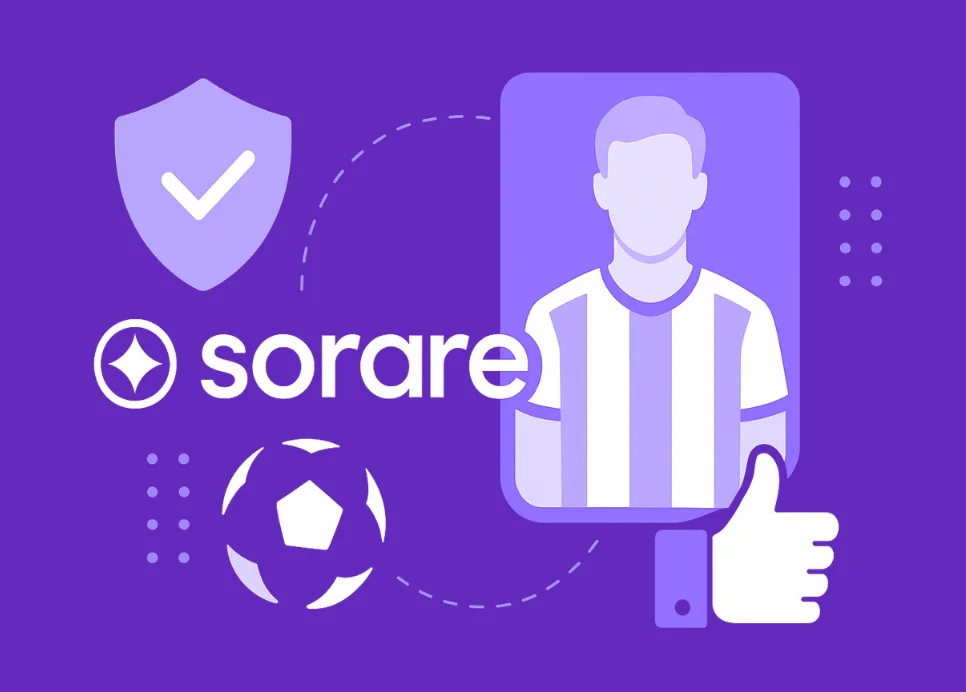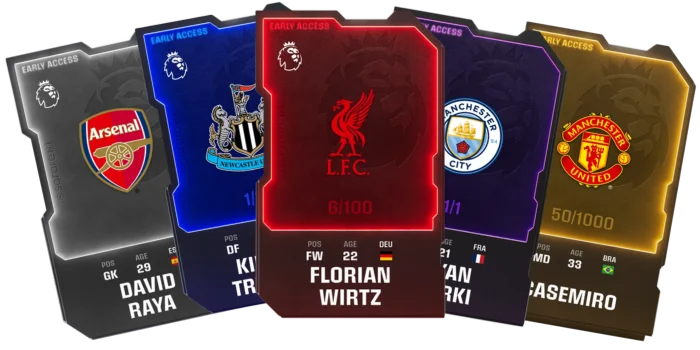If you’ve been on the lookout for an up-to-date Sorare review, it must mean you’re seriously considering joining the platform. And that’s great!
To make sure that you make the right decision, my review of Sorare has been written in the most unbiased way possible (which, quite frankly, wasn’t the easiest of tasks since I simply love the game).
But most importantly, it’s reviewing Sorare 26 – the newest “version” of the game. It’s crucial since the game we were playing 2-3 years ago is completely different from its current format.
As a Sorare manager with more than 3 years on the platform and experience of playing other fantasy sports games, I’m able to provide you with enough information to help you decide whether the game is for you or not. Pointing out both the good and the not-so-good sides to Sorare, I hope that the content below will help you decide whether joining the platform is the right move.
Sorare Review Overview
Pros
- Engaging & rewarding gameplay experience – win real cash, tradeable cards, in-game items, and real-life VIP experiences
- True ownership of cards – each card is trackable and you decide what to do with it
- Fully licensed leagues, teams, and players – win based on real-life events
- Continued card utility – cards can be used to win rewards for as long as the player’s career continues
- Multi-sport ecosystem – you can play across football, basketball, and baseball
- Free and paid access – you can test everything in the Sorare Academy before investing a single dollar
Cons
- Steep learning curve – it takes time to get good at the game
- Hard to win big without paying – competing for top prizes requires some form of investment
- Liquidity fluctuates – not all cards are easy to get rid of (especially of poor players)
- Pricing volatility: investing in the best players comes with bigger risk (eg. in case of a serious injury).
SIGN-UP OFFER
Register at Sorare using this sign-up offer and get free $150 to spend on cards.
Background of Sorare

Before you join the game, it would be good to know what Sorare is in the first place.
When I first discovered Sorare back in the early days, the concept seemed simple but ambitious at the same time – a fantasy football game using blockchain-based football cards.
The platform was created in 2018 by two French engineers, Nicolas Julia and Adrien Montfort. Their idea was to combine the unique nature of fantasy sports with real ownership of digital cards. At the time, it sounded like a bold experiment. Today, it’s a licensed, multi-sport platform used by over a million managers worldwide.
The growth wasn’t overnight. In the beginning, only a few European football clubs were licensed. But little by little, the roster expanded.
I remember how hyped the community was when Juventus and Atletico Madrid joined. Then came Real Madrid, Liverpool, AC Milan, and eventually… the probably the biggest addition – the English Premier League. That signing alone cemented Sorare’s reputation in the fantasy world. These licenses allow Sorare to use official player names, club logos, and real images on every card which helps the platform stand out from tens of competitors. Sorare is the real deal, we can say.

And it didn’t stop with football. In 2021, Sorare entered the U.S. market through a partnership with Major League Baseball. Then came the NBA. At first, I was hesitant since I wasn’t sure if fantasy basketball would catch on. But the rollout was smoother than I expected. Different scoring, different player types, and seasonal dynamics made it feel fresh instead of forced.
The addition of other sports brought a wave of new users with different strategies. I came across managers who never touched football but built amazing NBA lineups. Others play regularly across all three sports.
For me, the coolest part is that you don’t have to be fully locked in on one part of the game. You can focus on what you know, or experiment with a new league when the timing’s right. For me, football is still the main game, but when NBA season starts heating up, I can’t resist checking the card auctions 🙂
Introduction to Sorare cards

When I first heard about Sorare, I wasn’t exactly into NFTs. But once I realized these cards weren’t just digital collectibles (they were usable, tradable, and in limited supply), it started to click.
Every Sorare card is minted on the Ethereum blockchain, meaning it’s verifiably unique, publicly trackable, and truly owned by you.
This isn’t like traditional fantasy where you draft Harry Kane and share him with a million others. On Sorare, if you own a Rare Kane card, that’s your copy. You can use it in competitions, sell it, hold it, or vault it for passive rewards. And it will always be yours. That level of ownership is what made me stick with the platform long-term.
Unlike most other NFTs, Sorare cards aren’t speculative JPEGs. They’re active game pieces tied to real-world performance. That’s a big difference.
Rarity levels and supply limits
Cards come in five scarcities:
- Common
- Limited
- Rare
- Super Rare
- Unique
Each season, Sorare sets a maximum supply cap for each player at each level. Once those limits are hit, no more are minted for that tier.
| Scarcity | Best for | Max supply per season |
|---|---|---|
| ⚪ Common | Learning the basics, free entry | Unlimited |
| 🟡 Limited | New managers, casual gameplay | 1000 |
| 🔴 Rare | Core gameplay, better rewards | 100 |
| 🔵 Super Rare | Advanced users | 10 |
| ⚫ Unique | Elite players, collectors, whales | 1 |
From my experience, the sweet spot is Limited and Rare. That’s where you get solid rewards without breaking the bank.
Scarcity matters. The rarer the card, the fewer managers can use that player in a given Gameweek and the less people you compete agians. If you own a Super Rare midfielder who’s on fire, you’re suddenly in a much smaller competition pool – and that gives you a big edge.
Collecting vs playing cards
One of the things that makes Sorare interesting is the tension between collecting and competing.
Some managers buy cards purely for performance. Others chase cards with serial numbers that match the jersey numbers of players or assembling whole club collections for bonuses. I do a bit of both.
There’s a real strategy behind which cards you buy. Are you looking to flip it for profit? Use it in SO5? Complete a club collection to unlock bonuses? Vault it for passive rewards? Or just hold it as a fan of the team? Sorare allows for all of that. And depending on the player and season, your approach can shift.
Personally, I treat cards like assets. I buy when form dips or when a player is injured (assuming he’ll bounce back), and I try to sell when hype peaks.
But I also build collections — like the time I assembled an entire Borussia Dortmund 23/24 squad for the maximum Collection Bonus. That team not only earned me an extra 5% score boost… it just looked (and still looks) damn good in my gallery.
Bottom line? Sorare cards are more than tokens. They’re multi-use assets that reward strategy, timing, and — let’s be honest — a little bit of football obsession.
Review of Sorare gameplay experience

Sorare isn’t just about owning cool-looking digital cards… it’s about putting them to work!
Each Gameweek, you build lineups using the cards from your gallery, and those players score based on their real-life performance. From my experience, this is where the game gets really addictive. It’s the moment real football meets data-driven fantasy.
Each Gameweek lasts few days:
- Weekend Gameweek running from Friday to Tuesday
- Midweek Gameweek running from Tuesday to Friday.
You’ll have to register your teams before the deadline. Miss it, and your cards sit idle… and believe me, nothing hurts more than leaving out a player scoring 100 out of 100 points because you forgot to submit your lineup!
The goal is simple: score more points than the other managers in your division. The higher your team ranks on the leaderboard, the better the rewards – which can be Essence, XP boosts, market credits, and of, course, cash (lots of cash, in fact).
I’ve seen lineups earn over $5,000 in a single week… and also seen teams full of star players get crushed because one guy got sent off in the 6th minute. That’s the thrill (and pain) of Sorare.
Types of game modes
In the current game format – Sorare 26 – we distinguish between two main game modes:
- Sorare Academy – a free-to-play mode
- Sorare Pro – the mode with proper rewards for people willing to spend in order to win
Furthermore, Sorare Pro is divided into three sub-modes:
- Sorare In-Season (SO5)
- Sorare Classic (SO7)
- Sorare Classic Arena (SO5)
Have a look at the table below to learn about the differences between the Pro competitions.
| In-Season | Classic | Classic Arena | |
|---|---|---|---|
| Lineup Size | 5 players | 7 players | 5 players |
| Cash Prizes | ✅ | ❌ | ❌ |
| Card Eligibility | Mainly In-Season | All Seasons | All Seasons |
| Reward Types | Cash, Essence, XP | Cards, Essence | Essence, XP |
| Best Use Case | Cash-focused users with more to spend | Users with big galleries or smaller budgets | Users who prefer lesser competition |
Free-to-Play (Sorare Academy)
When I recommend Sorare to friends, I always tell them to start with the free mode. It’s called Sorare Academy, and it mimics the real game while letting you play 100% risk-free.
You’re given a set of Common cards, and you can enter starter competitions without spending anything.
SIGN-UP OFFER
Register at Sorare using this sign-up offer and get free $150 to spend on cards.
The free mode lets you get familiar with the scoring system, lineup strategies, and overall flow of the game. You even get daily and weekly packs to improve your team.
While you won’t win cash and tradeable cards here, you will earn free-to-play Essence and Gems, which are useful in upgrading your free-to-play squad. And if you’re competitive like me, you’ll find yourself trying to win even in the free divisions.
Sorare Pro: In-Season (SO5)
This is where things get serious.
Sorare In-Season competitions are the main cash-earning mode. You build 5-card lineups using mostly current-season cards (you’re allowed just one Classic card per team), and the prizes here include real money, Essence, and XP boosts.
The structure is simple:
- 1 GK
- 1 DEF
- 1 MID
- 1 FWD
- and 1 Extra (any outfield position)

Additionally, In-Season competitions offer 🔥 HOT STREAKS. This is an incredibly engaging game mode that allows you to get rewarded with cash for each point milestone you reach in consecutive GameWeeks.
Take a look at the infographic below to get the idea of how much you can win in the Hot Streak mode.
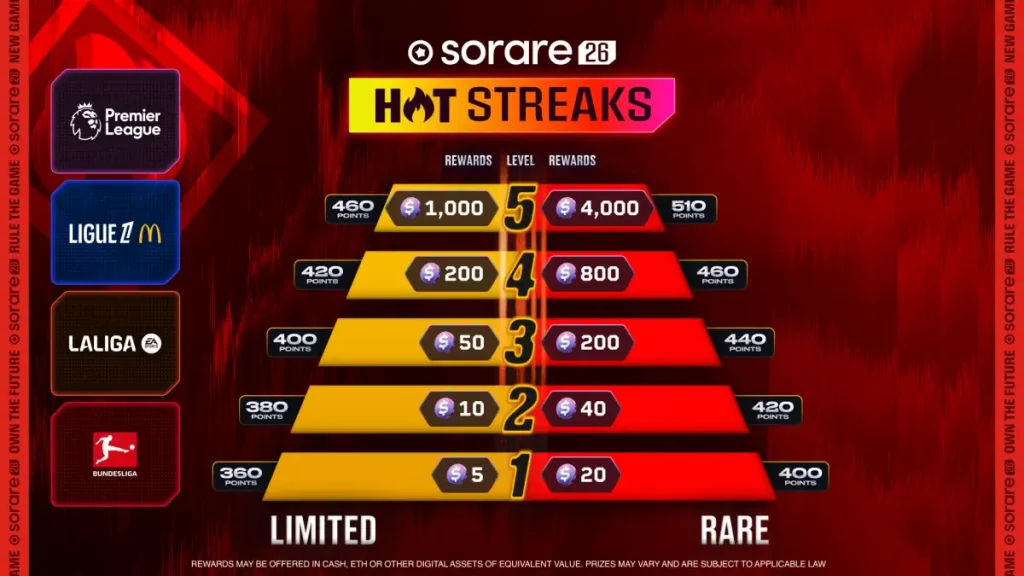
Sorare Pro: Classic Mode (SO7)
SO7 is a more flexible format. What you will find here are 7-card teams, no seasonal restrictions, and no cash payouts (at least not directly). Instead, you earn New Season cards, Essence, XP, and market credits.
The lineups include 1 GK, 2 DEFs, 2 MIDs, 1 FWD, and 1 Extra. It’s perfect for using older cards that still have value on the pitch but might not be eligible for In-Season competitions.

Sorare Pro: Arena Mode (SO5)
Arena is a new addition to the Sorare Pro Classic mode that was launched for the 2025/2026 season.
This mode lets you go head-to-head with just 9 other managers for a small Essence entry fee. It’s one of the most overlooked ways to grind steady progress (especially if you’re playing on a budget).
If you ask me, Arena is one of Sorare’s most under-appreciated features. It launched quietly but has become a regular part of my weekly grind. Instead of competing against thousands, you go up against just 9 other managers in a tight, 10-person contest.
Here’s the structure: you submit a 5-player lineup (same SO5 format like In-Season but with Classic cards), pay a small Essence fee, and compete in a mini-league.
Finish in the top 3, and you win more Essence than you paid. First place gets the biggest payout, while 4th and 5th get XP boosts. Everyone else walks away empty-handed.
To me, Arena is the best mode for playing mid-tier players in order to farm Essence while saving your best cards for the leaderboard competitions. It’s low-stakes, repeatable, and often easier to win if you do your fixture research right.
Scoring system and lineup mechanics
This part trips up a lot of new managers. Sorare’s Scoring Matrix is deeper than your average fantasy football game.

Each card scores between 0 and 100 points, and that score is split into two parts: the Decisive Score and the All-Around Score.
Decisive Score (DS)
This is based on game-changing actions: goals, assists, penalties won, red cards, errors leading to goals, and so on. Everyone starts at Level 0 (35 points), and then moves up or down depending on what they do in the match.
| DECISIVE SCORE | |
|---|---|
| POSITIVE | NEGATIVE |
| Goal | Red card |
| Assist | Own goal |
| Penalty won | Penalty conceded |
| Clearance off the line | Error leading to goal |
| Clean sheet (only keepers) | |
| Penalty saved (only keepers) | |
| Last man tackle | |
A hat-trick might push a player to Level 5 — a perfect 100. A red card? That’ll put your score to close to zero. You learn quickly which players are “score-safe” and which are high-risk, high-reward.
All-Around Score (AAS)
This part is more subtle. It rewards consistent, well-rounded play: successful passes, duels won, recoveries, interceptions. These events are weighted differently for each position. A center-back racking up clearances and passes can outscore a striker who disappears for 85 minutes.
From my experience, midfielders with high possession stats (successful passes, attempted assists, etc.) are the real hidden gems in the Matrix.
Captain multipliers and bonuses
Choosing a captain adds a 50% bonus to their final score.
That means a 70-point game can become 105… enough to tilt an entire leaderboard. I always look for players who are both consistent and explosive. Set-piece takers, penalty shooters, or midfield engines who never get subbed off. Those are my preferred captain picks.
Other bonus types
Sorare 26 introduces multiple bonus layers:
- Scarcity Bonuses (based on card type)
- XP Bonuses (card level)
- In-Season multipliers
- Multi-Club bonus (+2% if players come from 3+ different clubs)
- and Cap Bonuses (extra rewards for building efficient lineups under a point limit)
Honestly, these can make or break your lineup performance. Stack them smartly and your average squad starts punching above its weight.
Fixture planning and lineup strategy
I can’t stress this enough: fixture research is EVERYTHING. Is your player likely to start? Is the match away or at home? Are they coming off a midweek Champions League run? These things matter.
I always keep an eye on predicted lineups, injury reports, and opponent form before setting my lineups.
And always — always — submit early. Sorare deadlines are brutal. Miss it by a second, and that lineup won’t count. I learned this the hard way in 2022 and never again made that mistake.
PRO TIP: Already signed up for the game? Make sure to read my Sorare guide for beginners. It will make your first steps on the platform A LOT easier.
To sum up the gameplay review, I think it’s fair to say that the how the game works has come a long way since I started in 2021. What used to be a single tournament per week has now evolved into a rich, multi-layered experience with diverse entry points. Whether you’re chasing cash, building a deep Classic gallery, crafting cards, or just testing your football IQ… there’s a mode tailored for you.
The competition is tougher than ever in 2025, but if you’re consistent, informed, and just a little bit lucky… this game can reward you in ways that no other fantasy platform can. More about rewards? Next in this Sorare review.
Review of Sorare rewards and earnings
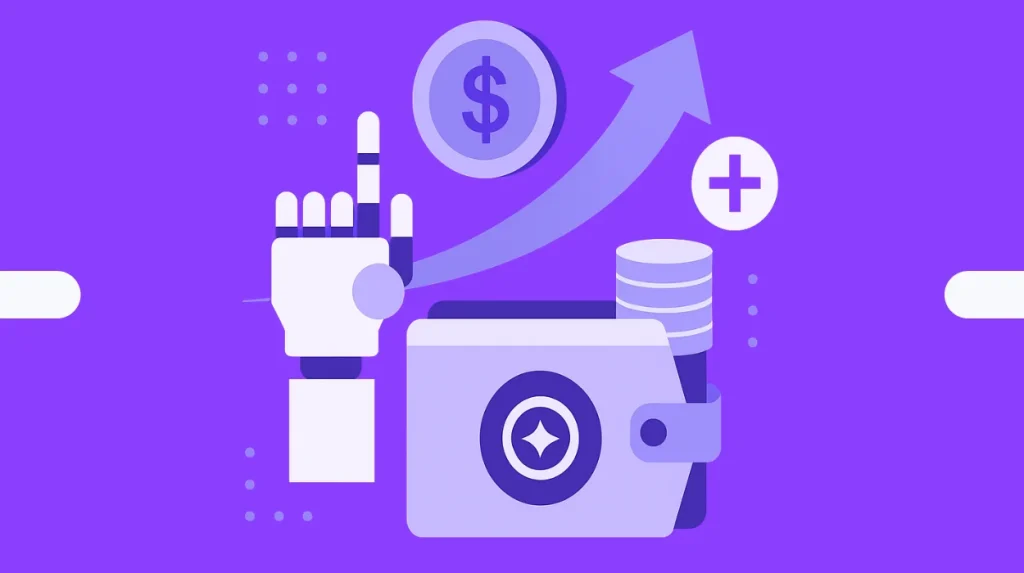
Let’s be honest — Sorare wouldn’t be nearly as fun if there weren’t real rewards on the line.
The platform offers several ways to earn: cash payouts, new cards, in-game currency (Essence), XP boosts, and market credits. The prize depends on the competition, your division, and your final placement on the leaderboard.
In-Season vs Classic rewards
In the In-Season (SO5) competitions, you can win anywhere from $5 to $10,000+ in a single Gameweek. Yes — really. I’ve personally had weeks where a Rare lineup pulled in over $500 in rewards… and others where I missed by a single point and got nothing.
Classic (SO7) competitions don’t pay cash, but they’re still rewarding. You can earn In-Season cards, XP boosts, Essence, and market credits to spend on auctions. If you’re patient, you can build a full gallery just by grinding the Classic mode.
Here’s my take: on one hand, Sorare is now paying out more cash than ever. But on the other, this cash is no longer available to everyone. To be able to compete for it, you need to own at least 4 In-Season cards – which basically means you have to put new money into the platform every year. I completely understand the reasoning behind Sorare’s decision to split the game into In-Season and Classic. If they didn’t, the platform wouldn’t be as prospering as it it is now… or maybe it wouldn’t be here at all! With stable influx of money that people spend on In-Season cards, Sorare is in the best financial position it has ever been. Do I miss the old days when I could keep earning cash with my old cards? Yes. Am I happy Sorare is still alive, so I can plan to enjoy the game for many years to come? Even more so!
Free-to-Play rewards
Sorare 26 brings amazing news for all the users who DON’T want to spend money right away!
SIGN-UP OFFER
Register at Sorare using this sign-up offer and get free $150 to spend on cards.
From August 2026, free-to-play users can now compete for cash rewards in any of the Common leagues (Bundesliga, French Ligue 1, English Premier League, Spanish La Liga).
The cash is paid out in the form of Sorare market credits once you reach the 4th and 5th milestones of 🔥 Hot Streaks.
Have a look at the screenshot below, which shows the reward path for the Common Bundesliga competition.
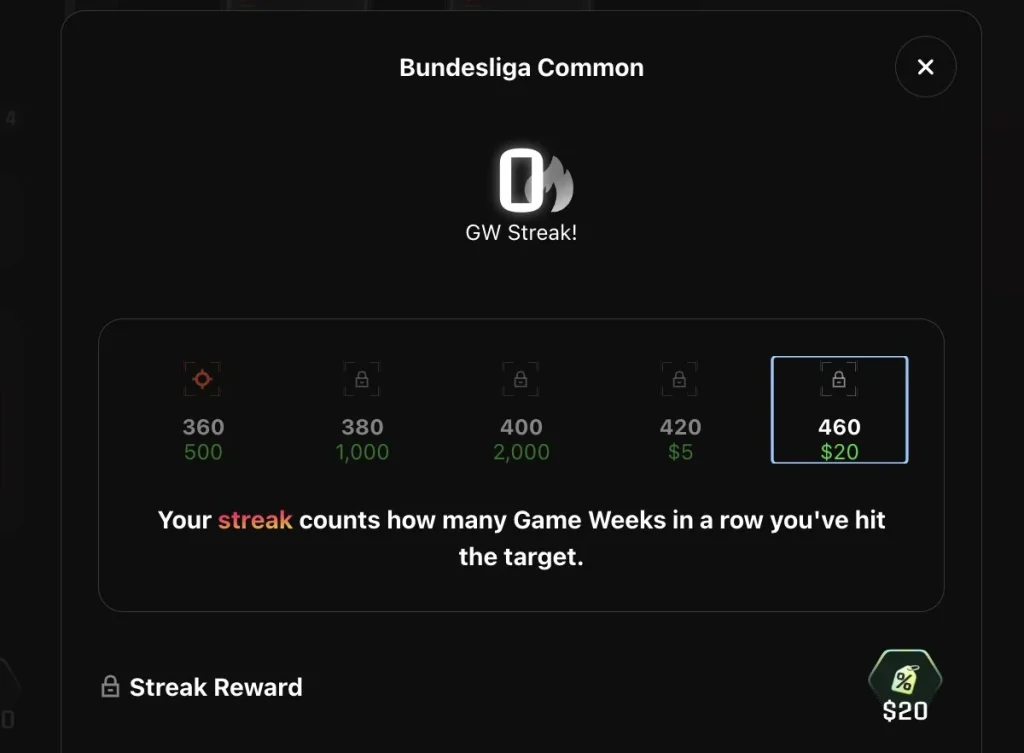
Real-life fan experiences
Cash and new cards are rewards I enjoy a lot on Sorare, but they’re not the only ones that get your heart pumping a bit faster.
If you’re a true football geek like me, you will be excited to hear that Sorare offers multiple opportunities throughout the year to win real-life VIP experiences. These include:
- VIP match tickets (eg. for El Classico between Real Madrid and Barcelona)
- Regular match tickets for you and your companions
- Meet-the-team experiences (eg. fly with AC Milan for their Champions League game)
- Meet-the-star experiences (play football with Zinedine Zidane or Kylian Mbappe)
…the list goes on.
Play-to-Earn potential
Is it possible to earn consistently with Sorare? From my experience — yes… but it takes strategy and discipline.
I started small, stuck to a Limited card budget, and slowly reinvested my winnings. Over time, I built a solid Rare roster that now competes in cash-paying divisions every week.
The play-to-earn model works best when you:
- Submit lineups consistently
- Research fixtures and lineups ahead of deadlines
- Make the most out of bonuses (XP, In-Season, Multi-Club, Cap)
- Use Arena to farm Essence and craft new cards
What worked best for me was treating Sorare like a marathon, not a sprint. I didn’t dump thousands into it from day one. I started with an affordable Limited squad, earned a few cards, reinvested, and scaled from there.
Even now, I’m selective with purchases. It’s about finding undervalued players, not chasing hype. Let me repeat – DO NOT CHASE HYPE. If you do, the challenge of making back your invested money becomes a lot more difficult.
What I love the most about competing for Sorare rewards is that even if you don’t win a prize every week, your cards retain some value. You can trade them or use them in a different mode next Gameweek. That kind of flexibility is rare in fantasy sports.
Game cost and accessibility

Although Sorare offers a year-round free-to-play mode (so theoretically you don’t have to pay to play), there’s no denying that the real fun starts when we put some money into the platform.
The game is considerably more accessible now than it was when I first joined. With the introduction of the Limited card scarcity (when Sorare first started, Rare cards were the lowest scarcity), you can easily create an In-Season team lineup for less than $50. And then use these cards to compete for cash and in-game items throughout the whole season!
Take a look at the table to get a better idea of the current entry price points (these include both In-Season and Classic cards).
| Division | Cards Needed | Average Cost Range |
|---|---|---|
| ⚪ Common | Free (5 Common cards) | $0 |
| 🟡 Limited | 5-7 Limited cards | $20–$100 |
| 🔴 Rare | 5-7 Rare cards | $60–$300 |
| 🔵 Super Rare & ⚫ Unique | 5-7 Super Rare and/or Unique cards | $500+ |
How much you spend depends on your goals (and budget). I can’t stress it enough – only spend what you can afford to lose.
I’ve seen players build competitive Limited lineups for under $50. I’ve also seen others drop five figures into Super Rares and play at the top of the leaderboard. Most of us fall somewhere in between.
Personally, I started small and scaled slowly. The nice thing is that your cards don’t lose utility after one Gameweek. You can reuse them in multiple competitions, across different modes, for as long as the player remains active in real life. That long-term usage spreads out the cost over time.
Also, don’t underestimate the value of smart timing. Buying during the offseason or after injuries can save you 30–50% compared to peak pricing. If you’re patient and follow form trends, you can build a solid team without overpaying.
💡 PRO TIP: If you haven’t yet joined the platform, make sure to do so by using my exclusive Sorare sign-up bonus (this way you’ll get free $150 credits to spend on your cards).
Free-to-Play opportunities
When people ask me if Sorare is expensive, I always tell them: it doesn’t have to be. You can start for free. And I mean that literally.
The Sorare Academy mode lets you build lineups using free Common cards. No credit card, no blockchain wallet, no commitment. Just your football brain and some patience.
This free entry point is actually underrated. You can test the platform, learn the scoring system, and even win your first few bucks in the Hot Streaks mode if you’re skilled enough!
I always recommend new users start here before diving into the paid side. It gives you time to figure out what kind of manager you are. Are you here to collect? Trade? Win rewards? Compete long-term? That clarity matters.
Deposit methods
In terms of accessibility, the platform supports fiat payments (credit or debit cards), so you don’t need to own crypto to get started. That’s huge. When I joined, ETH was the only option, and it scared people away. Now, buying cards is just as easy as any online purchase.
The mobile app works smoothly in most countries, and while certain prize pools vary by region (due to legal restrictions), almost everyone can still compete and win something. Whether you’re in the US, Europe, Latin America, or Asia, the chances are Sorare is fully playable in your country.
From my experience, the best thing about Sorare’s accessibility is that it lets you go at your own pace. You don’t have to grind daily. You don’t have to spend like a whale. You just need to stay smart, stay curious, and stay plugged into the game.
Buying & trading aspect of Sorare
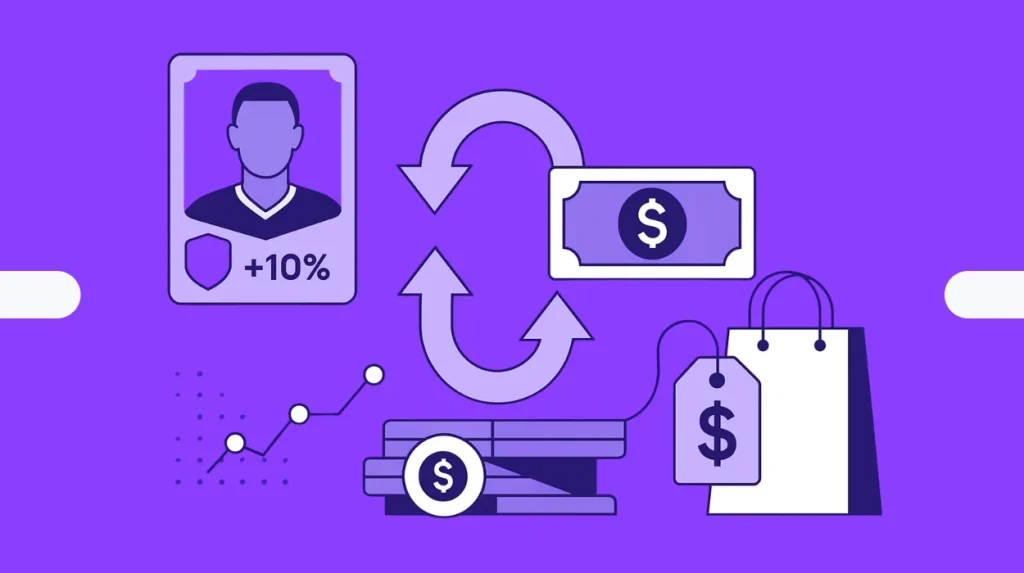
Playing Sorare competitions to win is one way to utilize the game. But so is card trading!
Sorare has two main marketplaces: the Primary Market and the Secondary Market. If you’re new, this distinction is crucial — and trust me, I’ve made enough mistakes in both to learn what works (and what doesn’t).
| Market Type | Who Sells | Payment Method | Buy Mechanism |
|---|---|---|---|
| Primary Market | Sorare (new cards only) | Cash/ETH balance, Credit card, Paypal, Apple Pay | Auction (highest bidder wins) or Instant Buy |
| Secondary Market | Other managers | Cash/ETH balance | Buy-it-now or negotiate via offers |
The Primary Market is where Sorare lists brand-new, freshly minted cards via Auctions or Instant Buys. You’re the first owner, and that gives you benefits (eg. more Collection points and guaranteed In-Season bonuses). Auctions typically last from a few hours to a couple of days. The earlier you spot a listing, the better your chances of sniping a deal.
Then there’s the Secondary Market, where managers list their own cards for sale. This is where I’ve done most of my buying over the years. You can browse cards by player, team, scarcity, or price. You’ll find current-season cards as well as older-season “Classics” that still carry value — especially in SO7 or collection building.
From my experience, auctions are great for buying hyped rookies early. But for depth, consistency, or price efficiency? Nothing beats finding that underpriced gem in the Secondary Market late at night when everyone else is asleep.
SIGN-UP OFFER
Register at Sorare using this sign-up offer and get free $150 to spend on cards.
When buying through auctions, always have a hard cap in mind. It’s easy to get caught up in last-minute bidding wars and overpay for a card just because someone else wants it. I’ve learned to set price alerts and walk away if the bidding goes over my limit. There’s always another card.
Manager Sales are instant. If a card is listed and priced right, you can grab it immediately. But don’t just buy the cheapest copy. Look for cards with high XP levels! I often pay slightly more if the card helps me hit a Collection Bonus milestone.
And don’t sleep on Direct Offers. If a card isn’t listed, search for owners and send a respectful offer. About 30% of my trades happen that way. If your offer is fair, people usually respond — especially if the player is underperforming or out of form.
Trading aspect
Trading is where Sorare starts to feel like a proper economy. You don’t have to be a trader to be successful, but understanding value trends helps.
Here are a few strategies that worked for me:
- Buy injured stars: Prices dip fast when a player goes down. If it’s a short-term injury, grab the card and flip once he returns.
- Target U23 players: Young talents who are about to break into the first team are undervalued until they explode. Scout ahead of the curve.
- Sell on hype: When a player hits a hat trick or goes viral, list immediately. Prices usually spike for 24 hours — then crash back down.
- Flip offseason cards: During the break, prices fall. That’s the time to stock up. As soon as fixtures return, demand skyrockets again.
From my experience, your goal should be simple: buy cards that will be more valuable in 2–4 weeks than they are today. That might mean predicting form, scouting youth talent, or just reacting quickly to injury news before the market adjusts.
I’ve never viewed Sorare purely as a trading platform because I play to win. But profitable trading lets me upgrade my gallery, fund new lineups, and stay ahead of the curve without needing constant investment into the game. That freedom is worth every bit of effort spent learning the market.
Sorare user experience
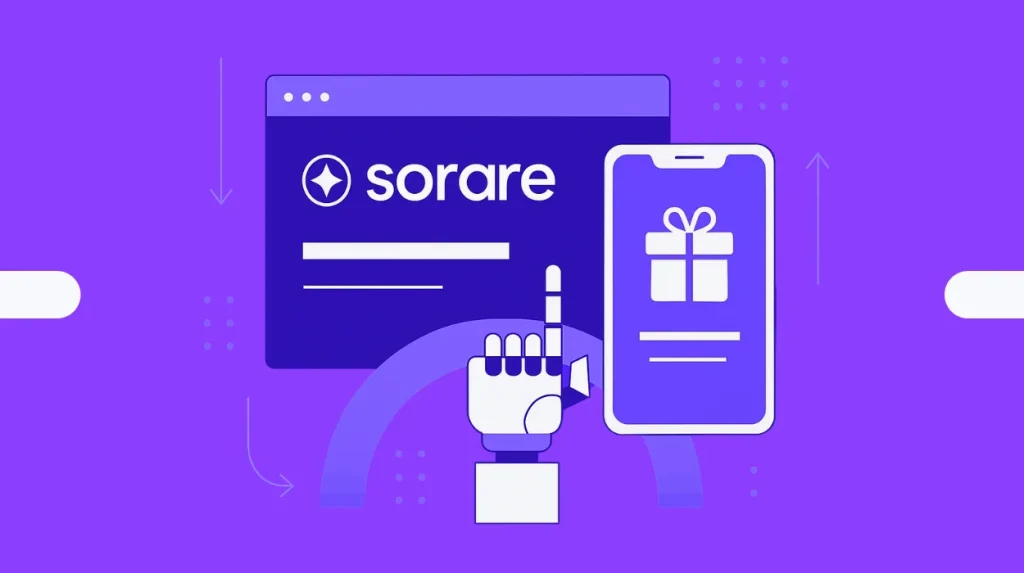
Back when I started playing Sorare, the platform was web-only and… let’s just say it wasn’t exactly polished. Fast-forward to now, and things look very different.
The desktop experience is fast, intuitive, and smooth — especially when building lineups or browsing the market. You can toggle between tabs, filter by card scarcity, and get real-time score updates during Gameweeks.
The mobile app, though, is where Sorare really stepped up. I use it every single day. Whether it’s submitting lineups on the go, checking captain choices 10 minutes before a deadline, or tracking live points — it’s (finally) all fluid. Crashes and glitches happen very rarely nowadays.
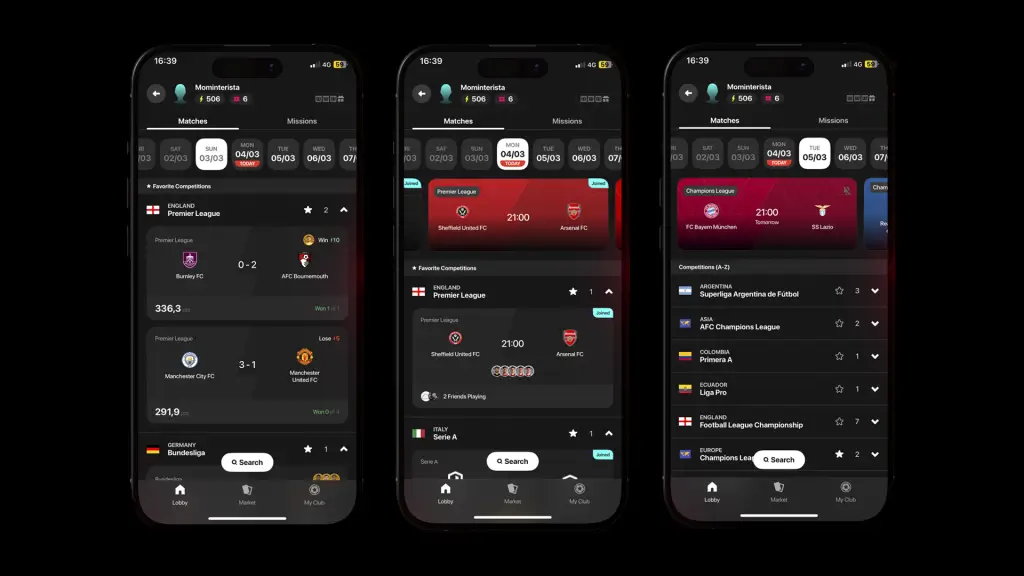
And the dark mode actually looks beautiful, which is more than I can say for some other fantasy apps I’ve used.
What worked best for me was linking notifications to lineup deadlines and injury news. That one change saved me from missing Gameweeks — and from accidentally fielding DNPs in cash-paying divisions. If you’re not using the app daily, you’re probably missing out on an edge.
Community aspect of Sorare
One of the best parts of Sorare isn’t even the gameplay… it’s the community.
Over the years, I’ve met managers from around the world. Some are all about flipping. Others run spreadsheets that look like NASA launch software. And some just love collecting cards of their favorite club — no matter the utility.
Sorare doesn’t have built-in chat rooms or leagues yet, but the external community fills the gap. Twitter (or X, whatever we’re calling it now), Discord, Reddit — the platform has a cult following. There’s always someone breaking news about a transfer, posting reward pulls, or rage-quitting after getting edged out of a Star card reward by 0.2 points (we’ve all been there).
From my experience, following community updates helped me stay ahead. For example, I learned off-season trading tips and even grabbed a few discounts by spotting panic sellers during injury scares.
Learning curve for beginners
Let me be honest — Sorare isn’t a plug-and-play experience. There’s a learning curve.
At first, you’re trying to figure out what XP means, why card bonuses matter, and how a center-back can outscore your striker. It’s overwhelming.
But once you get the basics — the Scoring Matrix, card scarcities, lineup structure — it clicks. And from that point on, every lineup you build feels like a small puzzle. That’s what hooked me.
Even now, three years in, I’m still tweaking tactics and learning new angles. Sorare keeps evolving, and that’s part of the fun.
For new users, my advice is simple: start in the free mode, build slow, and don’t chase hype. Focus on learning the scoring system, understanding player roles, and tracking performance trends. The rest will follow.
And when it does, you’ll start seeing Sorare not just as a game — but as a skill-based platform that rewards knowledge and patience.
Sorare vs other fantasy platforms & web3 games

I’ve been playing fantasy football for over a decade — FPL, DFS, even obscure local league apps. You name it, I’ve played it.
They’re fun, but the structure is always the same: salary cap, unlimited transfers every week, half your league owns the same top players, and the season resets to zero every August. If you’re lucky, you win bragging rights or maybe a gift card.
Then I found Sorare — and it changed the way I looked at fantasy sports entirely. Here, I’m not renting players… I’m collecting, leveling, and reusing them across dozens of Gameweeks. There’s no “reset.”
My Rare card of Arda Güler is still the same beast whether it’s 2022 or 2026 — and every week he plays well, I benefit. That continuity is something no other fantasy platform offers.
What also makes Sorare stand out is how it forces you to scout differently. In FPL, everyone piles into the same budget-friendly form players. In Sorare, you’re rewarded for finding the hidden gems — the U23 starter in Austria no one’s heard of, the backup keeper who just got promoted, or the set-piece taker in Korea. That discovery process is genuinely addicting.
For me, the real reason Sorare is a standout is because it blends four things better than any other platform:
- Fantasy gaming depth — lineup strategy, scoring mechanics, bonuses, formations, timing. It rewards smart decisions.
- Real ownership — cards are NFTs, stored on Ethereum, fully tradable. You control the asset, not Sorare.
- Performance-based earnings — your results come from real-life sport performance, not luck or market sentiment.
- Collecting appeal — every card has visual appeal, scarcity, and real-world connection to players you love (or scouted before anyone else).
Over the years, I’ve watched Sorare go from niche to mainstream without losing its competitive core.
The fantasy world is full of short-term gimmicks and disposable teams. But Sorare? It rewards people who actually understand football, think long-term, and know how to spot value. That’s why I’m still here — and why I think it’ll outlast the rest.
Security, safety, and legitimacy of the platform

One of the reasons I stuck with Sorare is the transparency built into the platform.
Every card is minted on the Ethereum blockchain. That means every transaction, sale, and ownership transfer is publicly recorded and verifiable. No hidden numbers. No “we’ll fix it in the back-end” situations.
From my experience, this makes a huge difference. If you buy a card, you can see exactly how many exist, when it was minted, what serial number it is, and who previously owned it. That level of transparency gives players confidence — and it’s (very) rare in fantasy gaming.
Sorare also uses Layer 2 scaling (via Starkware), which reduces gas fees and makes in-game transactions smooth and cost-free. You don’t need to worry about paying $20 to list a card for sale or confirm a trade. That tech decision alone keeps the game accessible for new users.
Data protection & account security
As for account safety, Sorare takes it seriously.
Two-factor authentication is supported and highly recommended — I activated it the moment real money got involved. You’re also able to monitor device logins, revoke sessions, and protect your connected wallets from any suspicious activity.
SIGN-UP OFFER
Register at Sorare using this sign-up offer and get free $150 to spend on cards.
In three years of playing, I’ve never experienced a hack, loss, or breach. I still suggest using a dedicated email for Sorare and enabling every security feature available — especially if your gallery grows in value. It’s better to over-prepare than regret it later.
All payment processing goes through trusted third-party providers, and Sorare never holds your credit card data directly. That’s another important layer of safety, especially for players entering with fiat currency.
Regulatory concerns
Let’s talk legality — because that question comes up often.
Is Sorare legal? Is it gambling? What if regulations change? Fair concerns, and I’ve followed the updates closely over the years.
Sorare has taken a proactive approach. They’ve registered with multiple jurisdictions, hired legal teams, and adjusted their prize distribution mechanics in certain regions to remain compliant. For example, in some countries, users only compete for cards and not direct cash prizes — depending on local laws.
It’s not a perfect science, and regulations around fantasy sports and digital collectibles are still evolving. But unlike some fly-by-night NFT games, Sorare has investor backing from serious players like SoftBank and Benchmark, plus individual endorsements from athletes like Kylian Mbappé and Serena Williams. That’s not something you see from short-term projects.
From my point of view, if Sorare was skating on thin legal ice, they wouldn’t be partnering with the Premier League, NBA, or MLB. The fact that these organizations have licensed their brands and players shows that the platform has done the hard work behind the scenes to stay above board.
Is it risk-free? No platform ever is. But Sorare has built a strong foundation — both technically and legally — and that’s why I continue to play, invest, and recommend it without hesitation.
What does the future hold for Sorare?

When Sorare added NBA and MLB, it wasn’t just a marketing move. It showed that the platform can adapt its core gameplay to other sports — all while maintaining depth and utility. I know tons of people who started with football, but now enter basketball lineups every week too. The scoring feels intuitive, and the same strategy DNA applies across sports.
What excites me long-term is how these ecosystems will intersect. More sports mean more players, more collectors, more volume — which leads to healthier markets and deeper reward pools.
Plus, global leagues keep the action going year-round. When Europe goes on summer break, MLB and MLS heat up. When basketball ends, football kicks back in. There’s no real offseason anymore.
From a collector standpoint, this also opens up cross-sport value. If you’re an NBA fan, your cards aren’t just static collectibles — they’re active assets.
Long-term value for players and collectors
One of the reasons I’ve stayed committed to Sorare is the long-term outlook.
This isn’t a hype-driven platform chasing pumps. It’s a game — one that’s building infrastructure, content partnerships, and a growing user base over time.
As more clubs, leagues, and players join the game, the collectible side of Sorare strengthens. Owning a Rare Haaland from his first season on the platform? That means something. And as real-world football evolves — new stars emerge, older players retire — those early cards start to feel like digital history books.
From a gameplay angle, the platform keeps rewarding users who are plugged in. If your lineup has a great week, you’re winning. That kind of skill-based economy is rare — and it’s why I believe Sorare will keep growing, long after the initial hype has died down.
So where is Sorare heading? Toward becoming a multi-sport, skill-based gaming ecosystem that blends fantasy, collecting, and trading into one platform. And for players like me — who enjoy the grind, the scouting, the weekend sweats — that’s exactly the kind of future I want to be part of.
Concluding the Sorare Review

All in all, Sorare, although not perfect just yet, is definitely a great place to be for all football fans and collectors.
After playing Sorare for over three years, I can confidently say it’s the most engaging fantasy experience I’ve come across. It rewards real sports knowledge, offers actual ownership of assets, and combines strategy, scouting, and collecting in a way no other game does.
Here’s what I like the most about Sorare 26:
- Ownership that matters: You don’t just “own” a player for a week — you hold a tradable, limited-supply card that stays with you as long as you want.
- Real utility: Cards aren’t static. They’re playable in competitions, usable for crafting, stackable for bonuses, and sellable at any time.
- Multiple reward types: You win cards, cash, Essence, XP boosts, market credits — each with a different use case.
- Multi-sport ecosystem: You can play across football, basketball, and baseball — and likely more in the future. That makes it easier to stay engaged year-round.
- Free and paid access: You can test everything in the Sorare Academy before investing a single dollar. Then scale into Pro mode only when you’re confident.
Now, Sorare isn’t perfect. I love the platform, but I’ve also been frustrated more times than I can count… and it’s only fair to highlight that too.
- Steep learning curve: For new users, it’s a lot. Between scoring rules, lineup caps, XP levels, and card bonuses, it can feel overwhelming at first.
- Liquidity fluctuates: Some cards are easy to sell. Others — especially out-of-form or niche-league players — might sit in your gallery for weeks while their prices drop further.
- Pricing volatility: Player prices swing fast. One injury or benching can drop a card’s value by 30% overnight. You need to stay active.
- No in-game leagues with friends: Unlike FPL, Sorare doesn’t yet let you compete privately with friends in a league table format. Hopefully this changes.
- Some features still missing: The app is great, but there’s still room for UI improvements, better notifications, and smoother filters in the Market section.
What’s helped me deal with the negatives is simply understanding the game isn’t passive. Sorare rewards managers who put in time — watching football, analyzing form, tracking injuries, researching minutes. If you treat it like a set-and-forget platform, you’ll probably be disappointed. But if you stay engaged, the upside is huge.
SIGN-UP OFFER
Register at Sorare using this sign-up offer and get free $150 to spend on cards.
And the best part is that every mistake teaches you something. Every misstep in the market, every lineup that flops, every card you sell too early — it all helps you improve for the next Gameweek.
If you feel like this Sorare review is missing some information you consider crucial, please don’t hesitate to contact me. I would love to help!

